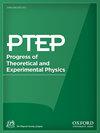The Petz (lite) recovery map for scrambling channel
IF 8.3
4区 物理与天体物理
Q1 Physics and Astronomy
引用次数: 1
Abstract
We study properties of the Petz recovery map in chaotic systems, such as the Hayden-Preskill setup for evaporating black holes and the SYK model. Since these systems exhibit the phenomenon called scrambling, we expect that the expression of the recovery channel $\mathcal {R}$ gets simplified, given by just the adjoint $\mathcal {N}^{\dagger }$ of the original channel $\mathcal {N}$ which defines the time evolution of the states in the code subspace embedded into the physical Hilbert space. We check this phenomenon in two examples. The first one is the Hayden-Preskill setup described by Haar random unitaries. We compute the relative entropy $S(\mathcal {R}\left[\mathcal {N}[\rho ]\right] ||\rho )$ and show that it vanishes when the decoupling is archived. We further show that the simplified recovery map is equivalent to the protocol proposed by Yoshida and Kitaev. The second example is the SYK model where the two-dimensional code subspace is defined by an insertion of a fermionic operator, and the system is evolved by the SYK Hamiltonian. We check the recovery phenomenon by relating some matrix elements of an output density matrix $\langle {T}|{R}[\mathcal {N}[\rho ]]|{T^{\prime }}\rangle$ to Rényi-two modular flowed correlators, and show that they coincide with the elements for the input density matrix with small error after twice the scrambling time.用于争夺通道的 Petz(精简版)恢复地图
我们研究了混沌系统中佩茨复原图的性质,比如蒸发黑洞的海登-普雷斯基尔(Hayden-Preskill)设置和SYK模型。由于这些系统表现出所谓的扰乱现象,我们预计恢复通道 $\mathcal {R}$ 的表达会被简化,只给出原始通道 $\mathcal {N}^\{dagger }$ 的邻接 $\mathcal {N}$ ,它定义了嵌入物理希尔伯特空间的代码子空间中状态的时间演化。我们通过两个例子来验证这一现象。第一个例子是由哈尔随机单元描述的海登-普雷斯基尔设置。我们计算了相对熵 $S(\mathcal {R}\left[\mathcal {N}[\rho ]\right] ||\rho )$,并证明它在解耦归档时消失了。我们进一步证明,简化的恢复映射等同于 Yoshida 和 Kitaev 提出的协议。第二个例子是 SYK 模型,其中的二维代码子空间是通过插入费米子算子定义的,系统由 SYK 哈密顿演化而成。我们通过把输出密度矩阵 $\langle {T}|{R}[\mathcal {N}[\rho ]]|{T^\{prime }}\rangle$ 的一些矩阵元素与雷尼-二模态流相关器联系起来来检验恢复现象,结果表明它们与输入密度矩阵的元素重合,并且在两倍扰码时间后误差很小。
本文章由计算机程序翻译,如有差异,请以英文原文为准。
求助全文
约1分钟内获得全文
求助全文
来源期刊

Progress of Theoretical and Experimental Physics
PHYSICS, MULTIDISCIPLINARY-PHYSICS, PARTICLES & FIELDS
CiteScore
12.00
自引率
5.70%
发文量
148
审稿时长
17 weeks
期刊介绍:
Progress of Theoretical and Experimental Physics (PTEP) is an international journal that publishes articles on theoretical and experimental physics. PTEP is a fully open access, online-only journal published by the Physical Society of Japan.
PTEP is the successor to Progress of Theoretical Physics (PTP), which terminated in December 2012 and merged into PTEP in January 2013.
PTP was founded in 1946 by Hideki Yukawa, the first Japanese Nobel Laureate. PTEP, the successor journal to PTP, has a broader scope than that of PTP covering both theoretical and experimental physics.
PTEP mainly covers areas including particles and fields, nuclear physics, astrophysics and cosmology, beam physics and instrumentation, and general and mathematical physics.
 求助内容:
求助内容: 应助结果提醒方式:
应助结果提醒方式:


